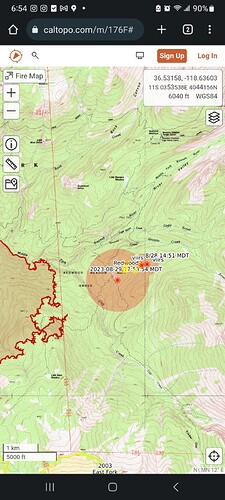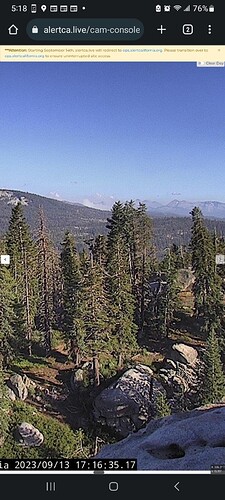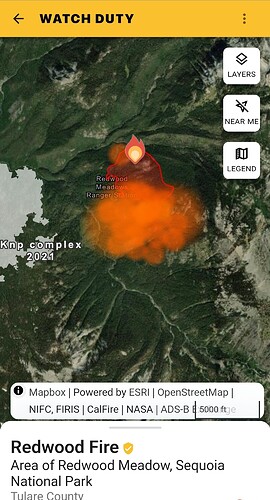This one is near Redwood meadow grove in Sequoia National Park, 75 acres.
Granite to the east, knp complex to the west, and flowing waters around. It’ll be a good public display of managed fire.
This was one of the locations the park did some emergency fuels work last year. That may provide a greater flexibility to get some good fire back on the ground in one of the few groves that hasn’t burned over the last few years.
ParkPlanning - Emergency Fuels Reduction within SEKI Sequoia Groves (nps.gov)
Or it may provide an opportunity to further stress some of our living treasures…why not put this fire out and burn during the winter to reduce fuel load? We simply do not know the effect fire will have in these long term drought conditions.
The SEKI are widely referred to as experts in the field of fire management use in the giant sequoias. The fact that this fire is 75 acres after ignition from a natural caused event, with what appears to be beneficial fire behavior, is a testament to the conditions in that area of the park. The folks at SEKI are using established best practices and following agency policy to ensure they are doing more benefit than harm. The other factor that comes in to play is risk analysis and values at risk. Is it worthwhile to get people hurt if a fire is beneficial and not posing any real risk to community infrastructure, public safety, and cultural assets? I’m sure all of these things have been considered through decision support systems and plans have been established to manage the fire in a safe, effective, and positive approach. Do people get it wrong sometimes? Yes. But we learn from those mistakes and reframe best practices as a result. If the fire is beneficial, let it continue to be beneficial, and when it becomes detrimental, fall back to the alternate plan, contingency plan, or heaven forbid emergency plan, which they have already prepared and planned for.
Seems to me…
1 - Our expertise is a bias. 2 - Statements assuming all credit goes to the humans w/out acknowledging that mother nature is allowing the conditions to be what they are no matter how we arrange or remove the fuels - it could all change in a blink of an eye because even “park like” settings are always 1 weather event away from uncontrollable fire. 3 - Our “best practices” have continuously become old past practices given enough time & hindsight. 4 - The field (temporally & spatially) that we develop and implement our best practices on does not jive with the reality of our ever changing planet let alone the solar system or galactic changes and cycles. That in part is why every generation i can think of continues to be caught off guard each time nature has a spasm and shows us who’s really in charge. 5 - No matter our efforts to serve the people & care for the land ALL of it will once again become glaciated, after that it will thaw and so on. All deserts will once again become tropics and redwoods will subduct into the sea or under another continent, etc. 6 - We live such short lives and our planet (with it’s different scale & clock) is constantly turning-over it seems like we (Land & Emergency Managers) are legislating, implementing, directing, enforcing, building & fighting in ways that keep us in the rut(s) we find ourselves in now… #Worried&Concerned!
The area this fire is in received some of the heaviest rainfall totals in the state over the spring. It is no longer in drought. Although there are likely some lingering effects from the prolonged drought, the trees were able to drink up as much water as they could want this spring. Even on the most recent passes of Sentinal and Landsat, the NDMI for the current perimeter is very blue (Wet).
It takes more than one wet winter for standing timber to recover from drought. These trees are a national treasure… why not give them the care and respect they deserve ? Here’s a clip from last year’s good intentions. Prescribed burn at Big Trees State Park may kill 2 iconic giant sequoias named “The Orphans” - CBS Sacramento (cbsnews.com)
Without wading too far into the management issue (not my territory), I’ll just say I’d be much more concerned if this fire broke out a year ago. I’m contemplating a trip into this area a few weeks from now. Checking Caltopo, the fire seems to be brushing up on this grove:
https://www.redwoodhikes.com/SequoiaNP/RedwoodMeadow.html
https://caltopo.com/map.html#ll=36.52964,-118.63689&z=14&b=t&a=c%2Cmba%2Cmodis_mp
The elevation here is around 6,000 feet which is still pretty much in the green zone thanks to all the precip we got last winter. Another fortunate event was the recent rain, the Sierra got a nice soaking a couple weeks ago, followed by a good solid couple of inches after Hilary rolled through. So much that the marshes are marshy and the mosquitoes re-hatched again. The big trees thrive with a little low-intensity fire, let’s just hope this is nothing more.
Thanks to everyone for your work & all your info.
@boomer , as you suggest as a SME, the big trees burn was completed nov 1 in the winter on the leading edge of a low that received heavy precip on the second day. There is always 2 sides or infinite sides to every discussion depending on politics, agendas or policy. Media creates the hype for views… In this case the presentation from the media is NOT the facts. Yet we are all entitled to our opinions.
"Fire management staff and park leadership have elected to utilize a confine and contain strategy to manage the Redwood Fire, located in the wilderness of Sequoia National Park, near Redwood Meadow. The lightning-ignited fire is currently 75 acres in size and burning at low intensity up a steep, forested slope. It currently poses no threats to life or property.
The Redwood Fire, discovered on August 15, is one of seven fires ignited by lightning throughout the parks during August, and is the only one of those that has shown any significant growth potential thus far. After the previous very wet winter and recent additional precipitation, moisture in the living vegetation has thus far done an excellent job of moderating fire behavior in the dense forest stand. The fire is burning in an area that lacks recent fire history and has the potential, especially under the current favorable conditions, to be beneficial to the landscape in this area.
A confine and contain strategy aims to ultimately suppress the fire within a larger footprint, utilizing a combination of natural and manmade barriers. This will allow the parks to limit the duration of smoke impacts, lessen the possibility of major changes or escalations in fire behavior, reduce unnecessary risk, and utilize firefighting resources that are currently available, while still getting the benefits of badly-needed fire in this area of the broader Sierra Nevada landscape.
Fire managers in the parks have identified a containment area of approximately 3,000 acres, bordered by features including the Cliff Creek Trail, Granite Creek, and large rocky areas to the east. The containment area also takes advantage of recent understory thinning and piling in the nearby Redwood Meadow Grove of giant sequoias. This work is part of the Sequoia Emergency Action Project, which aims to reduce the risk of future widespread high-severity fire in giant sequoia groves. The area in which the Redwood Fire is burning had already been identified by the parks as a high priority for fuels reduction, as it would provide protection for three groves at risk of catastrophic fire.
Fire managers plan to use a combination of hand and aerial ignitions to moderate fire behavior through areas with heavy fuels loads (for example, performing ignitions at the top of a slope to produce a backing fire, rather than allowing fire to run up a slope). The parks will continually evaluate current and anticipated fire behavior and are prepared to shift course if appropriate.
This management strategy stands in contrast to the 2020 Castle Fire and the 2021 KNP Complex, which also began with lightning strikes in wilderness areas, but were met with immediate full-suppression efforts. Despite these efforts, those fires went on to burn with such dramatic severity that they killed thousands of mature giant sequoias, losses unprecedented in the trees’ history. The severity of these fires was driven in part by drought exacerbated by climate change, and in part by the density of the forest stands after many decades of fire suppression.
Park leadership stresses that not only are conditions dramatically different this year due to fuel moistures, with readily observable differences in fire behavior from the start, but also that fire-inclusive management in this area represents an invaluable opportunity to prevent catastrophic losses, like those seen in 2020 and 2021, from occurring in the future.
“Right now, we have better conditions than we’ve had in years to work with fire on the landscape,” said Superintendent Clay Jordan. “A confine and contain suppression strategy for the Redwood Fire is our opportunity to put the devastating lessons learned from the Castle Fire and the KNP Complex into practice. It is our responsibility as land managers to work with fire when we can, in order to prevent catastrophic losses like we saw in those fires.”
Smoke from the Redwood Fire is very visible from high vantage points throughout the Giant Forest and Lodgepole areas, including Moro Rock. Smoke impacts from the fire can be expected in the foothills of Sequoia National Park and the community of Three Rivers. The parks are working with the San Joaquin Valley Air Pollution Control District to mitigate smoke impacts to the extent possible."
It’s understandable to be concerned about tree loss, especially iconic trees like the redwoods or giant sequoias. They’re huge, they live a long time, and they figure prominently in our nation’s identity (“…from the Redwood Forests, to the Gulf Stream waters…”). I recall having an old “View Master” when I was a kid with photos of the giant sequoias (VR for kids of the 60’s…). Most likely a tree with a hole cut through it and a car parked inside.
But, not to borrow old logging terms like “over mature” and “decadent,” all trees die. 100% of them. Zero percent of trees live forever. My perspective, if a type of tree generally lives to be 1500 years old, every year one out of 1500 will die. Given the fact that the vast bulk of what constitutes a tree is not “living” in the first place (wood and bark are dead tissue), it may get into a grey area when a tree actually dies unless it’s wiped out in a sudden event like a fire or windstorm.
After 10 years of mild conditions, within a small population of trees (1500 trees to make the math easy), maybe none fell over or torched beyond recovery, so people see that as status quo, zero tree loss. Then a tough winter storm rolls in, or a burn, or (fill in the blank) and the population of 1500 trees loses 10 trees. Irreplaceable, unmitigable resources lost.
I don’t want to downplay the significance of human activity on the forest composition; everything from habitat encroachment to timber production to changes in the climate and microclimates the trees inhabit. Soil compaction around the base of trees from people loving them, studying them, etc. However, the fact remains that all trees die. I also understand that this is likely a significant over simplification of the complex circumstances of tree survival and mortality.
From Inciweb
Update 9/4/23: Activity and growth on the Redwood Fire has plateaued following recent precipitation, but is expected to resume as fuels dry. Firefighters are in the field to reinforce and prep containment features surrounding the fire. The Redwood Meadow-Bearpaw Trail is closed to public travel from the junction with the Middle Fork Kaweah Cutoff Trail south to the junction with the Redwood Meadow Cutoff and Cliff Creek Trails (see map).
Fire management staff and park leadership have elected to utilize a confine and contain strategy to manage the Redwood Fire, located in the wilderness of Sequoia National Park, near Redwood Meadow. The lightning-ignited fire was last measured at 262 acres in size and burning at low intensity through a densely forested area. It currently poses no threats to life or property.
The Redwood Fire, discovered on August 15, is one of seven fires ignited by lightning throughout the parks during August, and is the only one of those that has shown any significant growth potential thus far. After the previous very wet winter and recent additional precipitation, moisture in the living vegetation has thus far done an excellent job of moderating fire behavior in the dense forest stand. The fire is burning in an area that lacks recent fire history and has the potential, especially under the current favorable conditions, to be beneficial to the landscape in this area.
A confine and contain strategy aims to ultimately suppress the fire within a larger footprint, utilizing a combination of natural and manmade barriers. This will allow the parks to limit the duration of smoke impacts, lessen the possibility of major changes or escalations in fire behavior, reduce unnecessary risk, and utilize firefighting resources that are currently available, while still getting the benefits of badly-needed fire in this area of the broader Sierra Nevada landscape.
Fire managers in the parks have identified a containment area of approximately 3,000 acres, bordered by features including the Cliff Creek Trail, Granite Creek, and large rocky areas to the east. The containment area also takes advantage of recent understory thinning and piling in the nearby Redwood Meadow Grove of giant sequoias. This work is part of the Sequoia Emergency Action Project, which aims to reduce the risk of future widespread high-severity fire in giant sequoia groves. The area in which the Redwood Fire is burning had already been identified by the parks as a high priority for fuels reduction, as it would provide protection for three groves at risk of catastrophic fire.
Fire managers plan to use a combination of hand and aerial ignitions to moderate fire behavior through areas with heavy fuels loads (for example, performing ignitions at the top of a slope to produce a backing fire, rather than allowing fire to run up a slope). The parks will continually evaluate current and anticipated fire behavior and are prepared to shift course if appropriate.
This management strategy stands in contrast to the 2020 Castle Fire and the 2021 KNP Complex, which also began with lightning strikes in wilderness areas, but were met with immediate full-suppression efforts. Despite these efforts, those fires went on to burn with such dramatic severity that they killed thousands of mature giant sequoias, losses unprecedented in the trees’ history. The severity of these fires was driven in part by drought exacerbated by climate change, and in part by the density of the forest stands after many decades of fire suppression.
Park leadership stresses that not only are conditions dramatically different this year due to fuel moistures, with readily observable differences in fire behavior from the start, but also that fire-inclusive management in this area represents an invaluable opportunity to prevent catastrophic losses, like those seen in 2020 and 2021, from occurring in the future.
“Right now, we have better conditions than we’ve had in years to work with fire on the landscape,” said Superintendent Clay Jordan. “A confine and contain suppression strategy for the Redwood Fire is our opportunity to put the devastating lessons learned from the Castle Fire and the KNP Complex into practice. It is our responsibility as land managers to work with fire when we can, in order to prevent catastrophic losses like we saw in those fires.”
Smoke from the Redwood Fire is very visible from high vantage points throughout the Giant Forest and Lodgepole areas, including Moro Rock. Smoke impacts from the fire can be expected in the foothills of Sequoia National Park and the community of Three Rivers. The parks are working with the San Joaquin Valley Air Pollution Control District to mitigate smoke impacts to the extent possible. For more information about smoke, visit https://fire.airnow.gov/.
299 acres
A combination of aerial and hand ignitions is planned to begin on Wednesday, Sep 13, and continue for about 7 days. Fire size is expected to increase to about 1500 acres throughout this time. This will allow firefighters to regulate the intensity of the fire as fuels are consumed. Regulating the intensity of the fire will help to ensure that there are favorable fire effects within the burned area, especially as the fire moves through giant sequoia groves.
is that smoke or clouds?
Smoke, the park ship was up there for aerial ignitions today.
NIFC just updated to 350 acres
Now 1158 acres of the 3000 projected.



